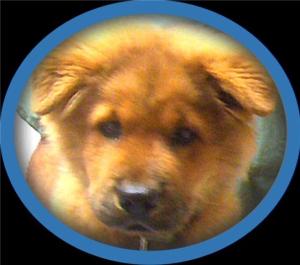Chow Chow Becomes Therapy Dog
When I met Bo, he was four pounds of red
fuzzy Chow puppy. Healthy, sassy, and a little nippy, Bo was a handful.
Naturally, Bo had to be taught bite inhibition. All puppies chew everything. They bite and gnaw on people, too. Gently teaching a puppy “no bite” consistently, firmly, and fairly goes a long way toward communicating proper puppy manners. When a puppy plays too roughly, firmly say the chosen words like “no bite.” Everyone in the family must use the same terminology for your puppy to understand.
How to Teach a Puppy Bite Inhibition
If your puppy still insists on roughhousing and nipping, then take away your attention by leaving the game. Do not be tempted into wagging or pointing your finger in the puppy’s face of holding the muzzle closed. This means fun to a puppy! If you have already tried these tactics, you know that the puppy becomes more hyper and tries even harder to play roughly!
As a last resort, super hyper puppies can be crated for a few minutes, like a 5 minute “time out.” They will connect the idea that roughhousing results in boring time spent alone in the crate.
Now, keep in mind, if anyone in the house (usually dad) is playing “hands,” rolling the pup, wrestling, on the floor at puppy level, allowing the biting play when it suits the human, your puppy will have a difficult time telling the difference between when roughhousing is allowed and when it is not. To keep the situation under control, be clear, and forego inappropriate, confusing animal play until a puppy is older and understands the family hierarchy.
Bo’s mom was a natural. By the time Bo was six months old, he sported his Gentle Leader, performed his obedience exercises, and looked fabulous in his full long fuzzy black Chow Chow coat.
That’s when Bo’s mom asked me an unexpected question.
“How do I get Bo certified as a therapy dog?”
The question surprised me a little bit because, usually, Chows are private, family dogs. They tend to tolerate strangers without enjoying their company.
Bo’s mom was certain he would make a good therapy dog.
I warned, “Don’t be disappointed if Bo doesn’t pass the test. Chows usually aren’t the obvious choice for visiting nursing homes and hospital wards.”
Bo participated in the Delta Society’s therapy dog certification program. He passed with high honors!
Bo loves his new job visiting senior citizens. He remains calm and relaxed, even around wheelchairs and IV poles. He is living proof anyone can become a therapy pet, with the right encouragement and training!
You and your dog can become a therapy team and provide amazing support and care to people in hospice care, children at risk, and hospitalized patients. Miracles happen when people give them a chance!
P.S. Doc Truli recommends this video about Baxter, a Chow-mix Therapy Dog. After a lifetime of service to people in need, even though paralyzed, Baxter visited hospice care patients and provided companionship and kisses, sometimes in the final hours of people’s lives.
from → Chow Chow, Dogs, Pet Stories



